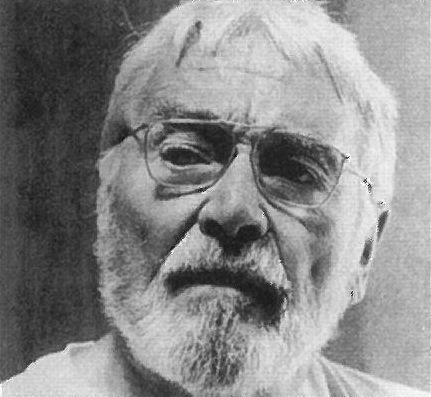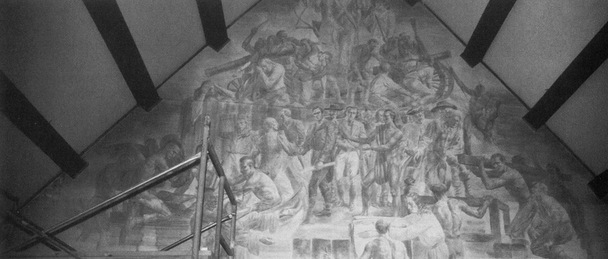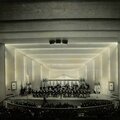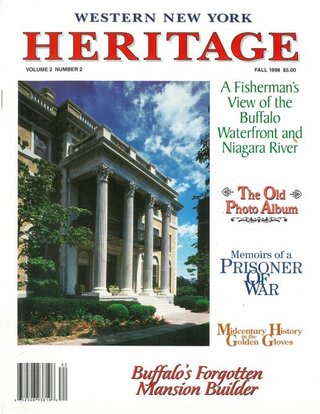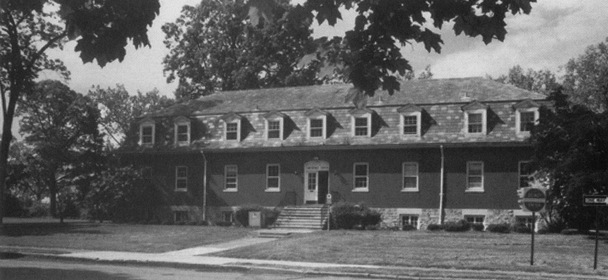
Fort Niagara Officers Club completed June 1938 was built by the Army G Quartermaster Corps. This building is decorated with some very unique painted murals.
Collection of David L. Dickinson
The fate of one of the most unique historical sites in our area, and a national military treasure, will be determined at a public hearing on December 3, 1998 to be conducted by the New York State Office of Parks, Recreation and Historic Preservation.
Earlier this year, preliminary plans submitted by a Lewiston developer for an “adaptive reuse project” at Fort Niagara State Park were revealed. Under the proposed project, the developer would lease four former Army buildings, which would be converted into a 70-room hotel, theater, inn and restaurant. The latter would be housed in the Officers Club building, which several groups have requested become a historical site and museum.
This building contains four murals that were examined in August by a noted art historian. She recommended that they be included in educational programs and preserved on the site. Three of the murals were painted between 1938 and 1940, most likely under the Works Progress Administration.
The Building
This building was officially opened on June 26, 1938. At that time the 28th Infantry Regiment was stationed at Fort Niagara. Their nickname was “The Lions of Cantigny” because of their tenacity in battle, defeating the Germans at Cantigny, France during WWI – the first American offensive of the Great War. The main room of the building was referred to as the Lounge or Ballroom. The dining room or Officers Mess is on the lower level on the north side of the building. The room directly opposite was the “Grille” or bar. It is now referred to as the Missile Room. Upstairs are several rooms in what appeared to be the original floor plan for the Bachelors Quarters. The unit arrived here in 1925 and departed in 1940 for training with other units to fight in WWII. From 1943 to 1945 the Fort was a Prisoner of War Camp with approximately 2,500 German and Austrian prisoners at the peak. The last military operation left the Fort in 1963. For a period of time in the 1970s, the building housed the offices of Artpark.
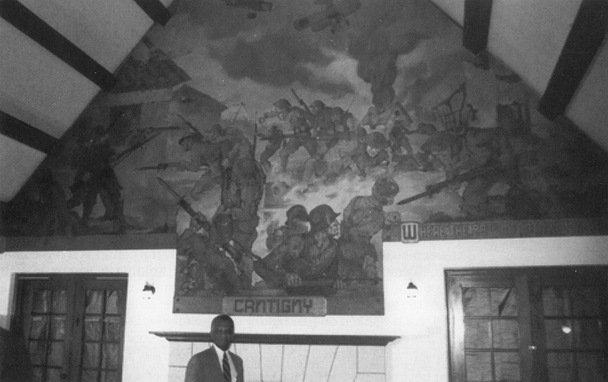
Battle of Cantigny, France May 28, 1918 painted by noted African American artist H.H. Crawford. This was painted as a Works Progress Administration project. The gentleman in the foreground is Derrick Byrd Jr., Member Board of Trustees, Western New York Heritage Institute.
Collection of David L. Dickinson
“The Battle of Cantigny” by Hubert H. Crawford
What is likely the first mural painted in the Officers Club is in the gable above the mantle of the stone fireplace at the west end of the Lounge. The painting depicts hand-to-hand combat between the soldiers of the 28th Regiment and elements of the German 18th Army, on May 28, 1918. Bi-planes circle above the background of the burning ruins of Cantigny. The solemn scene with the painted expressions of battle on the faces of its soldiers is a reminder of the nature of war and a memorial to the members of the unit who fought bravely for the principles of freedom and democracy. The mural is 28 feet across at the base and 20 feet high at the apex. Its deep and vivid colors are surrounded by an ornate oak border on which is carved the battle and date.
The mural is signed by “H.H. Crawford,” an African American artist and graduate of the Albright Art Gallery School of Buffalo, New York. Mr. Crawford’s other prominent work and defining piece was a depiction of the progress of the Negro in Buffalo during the 75 years since the Emancipation Proclamation, displayed at the American Negro Exposition in Chicago July 4th thru September 2nd, 1940.
“Defending Forts” by Eugene Dyczkowski
This 90-fort mural is in the Officers Dining Room (Mess). His painting depicts the evolution of warfare from the 16th century to the early 20th century. It is a Works Progress Administration project, completed in 1939. The artist is a graduate of the Albright Art School, the founder of the Polish Arts Club of Buffalo, and first president of the American Council of Polish Cultural Clubs.
“The U.S. at War” by Major Tom Loftin Johnson
This three-paneled mural is in the Officers Bar (Grille). This painting depicts the Campaigns of the 28th Regiment prior to WWII: Mindanao, Philippines...Cuba...and Vera Cruz, Mexico. The artist is a well-known American muralist, in particular for his work “Fifteen Decisive Battles of the World” a 1936 WPA project in Washington Hall, at the US Military Academy, West Point. The artist later went on to become an art instructor at the Academy in the mid 1940s.
“American History” by Ernst Wille
This mural sits above the entrance at the east end of the Lounge. In contrast to the painting at the opposite end, its colors are universally soft. Over three dozen figures are depicted: Native Americans, French Explorers, British Colonialists, and American settlers and soldiers of several eras, telling the story of Fort Niagara’s history. Frenchman Rene-Robert Cavelier, early explorer of the Niagara Frontier is in the green coat on the right side of the mural. In the center is a red-coated Englishman and Native Indian together holding a wampum belt, representing a treaty between the two parties. A gun crew of the Revolutionary War period is in a scene at the upper right. At the apex of the mural stands an American Militiaman with the Stars and Stripes in his left hand. He is flanked on his right by a departing French Colonial soldier in white uniform, and on the left a British soldier with Union Jack. In the bottom corners are two modern era soldiers pointing inward toward the Niagara River where the “Griffon” is at anchor.
The mural was painted between 1944-45 by a German prisoner of war who was captured on D-Day at Normandy by the Canadian Regiment de la Chaudiere. His painting was unfinished and unsigned when he was transferred out after the defeat of Germany in Europe. A local artist, Irene Collesano finished the feet on the European figures in the lower right corner of the mural. In 1976, Mr. Willie returned to Fort Niagara and signed his work. In May of this year, Professor Willie returned again to attend a reception hosted by NYS Office of Parks, Recreation and Historic Preservation.
